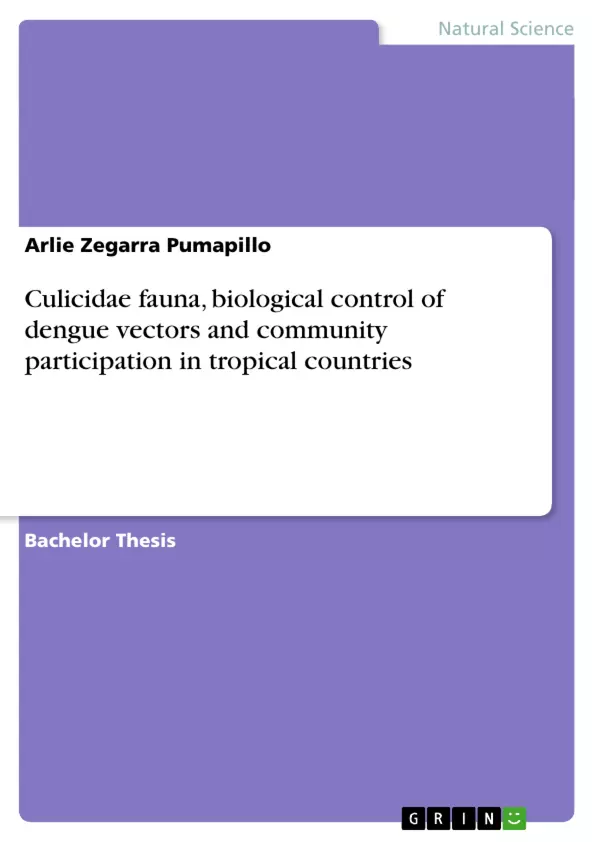Mosquito (Culicidae) fauna, biological methods to control Ae. aegypti larvae and community participation regarding the present dengue situation and vector control program were evaluated in Chulucanas district, Piura Department, Peru. The study included collection and identification of mosquito larvae in surrounding towns of and in Chulucanas city. Following mosquito species were found: Ae. aegypti, Ae. scapularis, Ae. serratus, An. albimanus, An. pseudopunctipennis, Cx. nigripalpus and Cx. pipiens quinquefasciatus. Two comparative residual effect tests with Bti-based Culinex Tab plus® and Temephos-based Temefar® 1%G were performed in large and small water volumes under laboratory conditions. In the tests with large water volumes, Temefar® 1%G and Culinex Tab plus® showed a residual effect of 9 weeks (100% and 75% mortality, respectively), and, in tests with small water volumes, a residual effect of 7 weeks (100% mortality for both larvicides). Three efficacy tests performed with Culinex Tab plus® at three houses in Chulucanas city under field conditions showed 100% mortality after 24 h of larvicide application. In connection with this tests, an adult person living in each house was interviewed regarding Bti- and Temephos-based larvicides, the present vector control program and community participation. Considering these interviews, a personal testimonial, other statistical social data such as poverty levels, socioeconomic indicators and one survey concerning approval of the present vector control program, it is concluded that lack of knowledge of handling with larvicides and low acceptation regarding present vector control activities may be the main causes for the dengue outbreak in June, 2008.
Inhaltsverzeichnis (Table of Contents)
- Abstract
- Introduction
- Materials and Methods
- Mosquito fauna in the district of Chulucanas
- Larvae collection, larval density, biotic & abiotic data
- Larvae identification
- Residual effect test of Bti- and Temephos-based larvicides
- Residual effect tests in large water volumes
- Residual effect tests in small water volumes
- Efficacy test in houses and interview regarding community participation
- Efficacy test
- Interview
- Mosquito fauna in the district of Chulucanas
- Results
- Mosquito fauna in the district of Chulucanas
- Breeding site in Chulucanas city, Sector Nr. 20
- Breeding site in Chulucanas city, Sector Nr. 4
- Breeding site in Yapatera town
- Breeding site in Campanas town
- Breeding site in Charanal town
- Breeding site in Paccha town
- Residual effect test of Bti- and Temephos-based larvicides
- Residual effect tests in large water volumes
- Residual effect tests in small water volumes
- Efficacy test in houses and interview regarding community participation
- Efficacy test
- Interview
- Mosquito fauna in the district of Chulucanas
- Discussion
- Mosquito (Culicidae) fauna in the district of Chulucanas
- Residual effect test of Bti- and Temephos-based larvicides
- Efficacy test in houses and interview regarding community participation
- Acknowledgements
- References
Zielsetzung und Themenschwerpunkte (Objectives and Key Themes)
This Bachelor thesis aimed to evaluate the mosquito fauna in the Chulucanas district of Peru and assess the efficacy of different larvicides for controlling Aedes aegypti, the vector of dengue fever. The research focused on three key areas:- Identifying the mosquito species present in Chulucanas and their breeding sites.
- Comparing the residual effects of Bti-based Culinex Tab plus® and Temephos-based Temefar® 1%G larvicides.
- Analyzing the efficacy of Culinex Tab plus® in real-world settings and exploring the role of community participation in dengue vector control.
Zusammenfassung der Kapitel (Chapter Summaries)
This chapter summarizes the findings on the mosquito fauna in the Chulucanas district, including the identification of 7 species (Ae. aegypti, Ae. scapularis, Ae. serratus, An. albimanus, An. pseudopunctipennis, Cx. nigripalpus, Cx. pipiens quinquefasciatus) and 5 unidentified larvae. The chapter further discusses the abiotic and biotic conditions found in each breeding site and provides detailed information on the geographical distribution, vector capacity, and ecological preferences of each identified species.
This chapter details the results of the residual effect tests of Bti- and Temephos-based larvicides. Temephos-based Temefar® 1%G demonstrated superior persistence than Bti-based Culinex Tab plus® in both large and small water volumes. While Culinex Tab plus® showed promising initial efficacy, its persistence was influenced by factors like dust contamination and water volume, suggesting the need for further research and development of more resistant formulations.
This chapter presents the findings of the efficacy test conducted in three households in Chulucanas city, confirming a 100% mortality rate of Ae. aegypti larvae after 24 hours of Culinex Tab plus® application. The interview conducted with residents of these households revealed varying levels of knowledge and attitudes towards larvicides and community participation in dengue vector control, highlighting the need for effective community engagement strategies.
Schlüsselwörter (Keywords)
This research focused on the Culicidae fauna, biological control of dengue vectors, specifically the Aedes aegypti mosquito, in tropical countries. The study investigated the effectiveness of different larvicides, including Bti-based Culinex Tab plus® and Temephos-based Temefar® 1%G, and the impact of community participation on vector control programs. Key themes included mosquito species identification, breeding site analysis, residual effect testing, efficacy evaluation, and community engagement.- Citation du texte
- Arlie Zegarra Pumapillo (Auteur), 2008, Culicidae fauna, biological control of dengue vectors and community participation in tropical countries, Munich, GRIN Verlag, https://www.grin.com/document/117842



